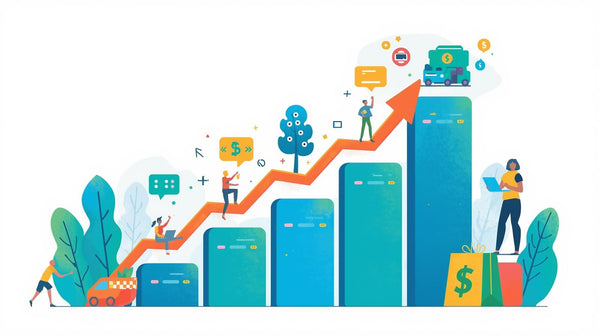Switching from Weebly to Shopify:
A Comprehensive Guide for E-commerce Growth
Switching your online store’s platform can seem daunting, but it is often the key to unlocking your business’s full potential. Weebly and Shopify are two popular platforms for creating and managing online stores, each offering unique benefits. However, Shopify stands out as a specialized solution for e-commerce, providing unmatched tools for scalability, customization, and business growth. In this guide, we’ll dive into why switching from Weebly to Shopify might be the best move for your business, the step-by-step process of making the switch, advantages and disadvantages, and how our agency, EcomSpiders, can help you make the transition seamlessly.
Why Consider Switching from Weebly to Shopify?
As your business grows, you’ll likely start feeling the limitations of Weebly’s ecommerce tools. While it’s a solid starting point for basic websites, it often falls short for serious online retailers. Shopify is purpose-built for ecommerce, offering advanced inventory management, powerful integrations, and industry-leading checkout experiences. Unlike Weebly, Shopify gives you full control over your store’s design, product structure, marketing automation, and multichannel selling all from one dashboard. That makes it a natural next step for businesses that want to scale without the technical headaches.
1. Designed for Scalability
Weebly is great for beginners, but when your business begins to grow more products, more customers, more traffic it often becomes a bottleneck. Shopify is built with scalability in mind. It can handle thousands of products, global expansion, and high traffic spikes without a hiccup.
What sets Shopify apart is its robust infrastructure and cloud-based hosting. You don’t need to worry about server downtimes or technical maintenance. Whether you're launching flash sales or running influencer campaigns that drive major traffic, Shopify keeps your store running fast and smooth.
Key highlights:
-
Handles high-volume traffic and transactions
-
No manual server maintenance needed
-
Supports large-scale product catalogs
2. Deep Customization at Every Level
Shopify gives you complete freedom to shape your online store the way you envision it. Its ecosystem includes:
-
Over 7,000 apps in the Shopify App Store
-
Hundreds of premium and free themes
-
Support for custom code via the Liquid templating language
Whether you're focused on creating a visually unique storefront or integrating specific tools like subscription services, inventory tracking, or multilingual support. Shopify has you covered. You can easily extend your store’s capabilities without relying on clunky plugins or outside hacks.
3. Built-In E-commerce Optimization
Shopify isn’t just a website builder. it’s a full-fledged e-commerce engine. From the ground up, it's optimized to improve conversions, streamline the shopping experience, and support omnichannel sales.
Some standout e-commerce features include:
-
Built-in payment gateways and express checkout
-
Abandoned cart recovery tools
-
Multi-currency and international support
-
Dynamic checkout buttons that adapt to user behavior
It also integrates smoothly with social channels like Instagram, Facebook, and TikTok, so you can manage all your sales in one unified dashboard.
4. Always-On Customer Support
Running an online business means issues can pop up at any time. Shopify offers 24/7 customer support via live chat, email, and phone a huge step up from Weebly’s more limited help options.
In addition to official support, Shopify has a strong, global community of merchants, developers, and Shopify Experts who regularly share tips, tutorials, and custom solutions.
What you get:
-
Instant help around the clock
-
Access to a rich knowledge base
-
Vibrant community forums and expert advice
5. Powerful Marketing Features Out of the Box
Shopify makes it easy to attract, convert, and retain customers. Unlike Weebly, Shopify comes with a suite of built-in marketing tools and seamless integrations with popular platforms.
Some features that give your marketing a boost:
-
SEO tools for optimizing product pages and meta descriptions
-
Built-in email campaigns
-
Facebook, Instagram, and Google Shopping integrations
-
Social ad performance tracking
For advanced users, Shopify works effortlessly with tools like Klaviyo, HubSpot, and Mailchimp, helping you build out segmented campaigns and automated workflows.

6. Better Reporting and Business Intelligence
One of Shopify’s strongest advantages over Weebly is its robust reporting and analytics. It offers real-time data and customizable reports that help you understand every part of your sales funnel.
You can view:
-
Customer behavior reports
-
Sales trends by product, location, or device
-
Conversion and checkout analysis
-
Marketing performance tracking
With Shopify Advanced or Plus, you also get access to cohort analysis, customer lifetime value metrics, and deep segmentation — features rarely seen in platforms at this price point.
7. Seamless Third-Party Integrations
Running an efficient business means using the right tools and Shopify connects with almost all of them. Whether you're handling accounting, shipping, CRM, or customer support, Shopify integrates effortlessly.
Popular integrations include:
-
QuickBooks and Xero for accounting
-
Mailchimp and Klaviyo for marketing
-
ShipStation and Shippo for shipping logistics
-
Zendesk and Gorgias for support ticketing
You won’t need to jump through hoops or pay for custom development just plug and play.
8. Mobile-First Experience
In today’s mobile world, a store that doesn’t perform well on smartphones is leaving money on the table. Shopify’s themes are built with mobile responsiveness in mind. The checkout flow, product display, and navigation all adapt seamlessly to smaller screens.
Plus, with the Shopify Mobile App, you can manage your business on the go update inventory, fulfill orders, or monitor live traffic, all from your phone.
Mobile advantages:
-
Mobile-optimized themes
-
Smooth, responsive checkout
-
Manage your store via mobile app
9. Access to Expert Help and Custom Services
Shopify isn’t just a platform it’s a full ecosystem of professionals. Through the Shopify Experts program, you can easily find developers, designers, SEO specialists, and marketers to help elevate your store.
This is crucial for businesses that need:
-
Custom design and branding
-
Advanced SEO or conversion optimization
-
Specialized marketing strategies
The level of professional support available is unmatched, giving you peace of mind when it’s time to upgrade or expand.
10. Shopify’s Commitment to Sustainability
Shopify has made public strides in promoting sustainable e-commerce. The platform supports carbon-neutral shipping options and partners with eco-friendly apps, helping merchants reduce their environmental impact.
If you’re a business that cares about ethical practices, Shopify helps you align with customers who value transparency and sustainability.
Why it matters:
-
Carbon-neutral delivery tools available
-
Partnered with green initiatives
-
Aligns with socially conscious consumers

How to Transition from Weebly to Shopify
Switching platforms requires careful planning to avoid disruptions and ensure all your data is preserved. Follow these steps for a smooth transition:
Step 1: Plan Your Migration
Identify your current store’s features and functionalities that are crucial for your business. Make a list of must-haves in Shopify, such as apps for inventory management or tools for email marketing.
Step 2: Export Data from Weebly
Weebly allows you to export your product information, customer details, and order history. Save these as CSV files to ensure you have a complete backup of your data.
Step 3: Set Up Your Shopify Store
-
Sign Up: Create a Shopify account and choose a pricing plan that fits your business.
-
Choose a Theme: Shopify offers free and premium themes. Select one that aligns with your brand and customize it to reflect your unique style.
Step 4: Import Data into Shopify
Use Shopify’s native import tools or third party migration apps to transfer your data. This includes product details, customer information, and images. Double-check that all data is accurate.
Step 5: Integrate Apps and Tools
Shopify’s app store offers a wide range of tools for marketing, shipping, accounting, and more. Install and configure apps to replicate or enhance the functionalities you had on Weebly.
Step 6: Test Your Store
Before going live, conduct thorough testing. Check navigation, product pages, checkout processes, and mobile responsiveness to ensure a seamless shopping experience.
Step 7: Redirect Your Domain
Update your domain settings to point to your new Shopify store. This ensures your existing customers can find your store without interruptions.
Advantages of Shopify Over Weebly
-
SEO Optimization
Shopify’s advanced SEO tools help improve your store’s visibility on search engines, driving more organic traffic. Shopify’s SEO-friendly features include customizable meta tags, URL structures, and built-in analytics tools, making it easier to track and optimize your performance. -
Better Payment Options
Shopify supports over 100 payment gateways, including Shopify Payments, PayPal, and Stripe, offering customers greater flexibility. This wide range of options ensures a smooth checkout process and builds trust with buyers. -
Global Reach
With multi-currency and multi-language support, Shopify enables you to cater to international audiences. Features like automatic currency conversion and localized shipping rates help streamline the buying experience for global customers. -
Data-Driven Insights
Shopify’s analytics dashboard provides in-depth insights into customer behavior, sales trends, and marketing performance. Advanced reporting tools allow you to measure the effectiveness of your strategies and make data-driven decisions to grow your business. -
Robust Security
Shopify offers SSL certification, PCI compliance, and regular updates to keep your store and customer data secure. This peace of mind is invaluable when handling sensitive customer information. -
Customizable Apps and Themes
The extensive range of apps and themes available in Shopify’s marketplace means you can tailor your store to meet specific business needs, from marketing automation to inventory management.

Potential Challenges When Migrating
-
Learning Curve
Shopify’s advanced features may take time to master, especially if you’re new to the platform. The good news is that Shopify’s extensive tutorials, documentation, and community forums make it easier to get up to speed. Partnering with experts like EcomSpiders can also help simplify the process. -
Costs
Shopify’s monthly subscription fees and additional costs for apps may be higher than Weebly. However, the ROI often justifies the investment due to improved functionality, higher conversion rates, and better customer retention. -
Initial Setup Effort
The migration process involves multiple steps, from data export to design customization. While this requires effort, the long-term benefits of switching to Shopify far outweigh the initial work. Partnering with a professional team can significantly reduce the time and stress involved. -
Data Migration Risks
Moving large amounts of data comes with risks, such as missing files or errors during transfer. Ensuring proper backups and working with experts can mitigate these challenges.
How EcomSpiders Can Help
At EcomSpiders, we specialize in Shopify migrations and optimizations. Here’s how we can make your switch effortless:
- Data Migration: We’ll ensure all your products, customer data, and orders are transferred without errors. Our process includes data validation to ensure accuracy and completeness.
- Design Customization: Our team can create a stunning Shopify store that reflects your brand identity. We focus on creating intuitive designs that enhance user experience and drive sales.
- App Integration: We’ll recommend and install the best apps to enhance your store’s functionality, including marketing tools, inventory management solutions, and customer engagement features.
- Performance Optimization: Beyond migration, we ensure your store runs smoothly with fast load times, mobile responsiveness, and optimized checkout processes to improve customer satisfaction.
- Ongoing Support: Post-migration, we offer support and maintenance to keep your store running smoothly. From troubleshooting to feature upgrades, our team is here to help at every step.
- Training and Guidance: For businesses new to Shopify, we provide training sessions to help you and your team navigate the platform with confidence.
- SEO and Marketing Strategy: Our team can help optimize your store for search engines, ensuring better visibility and higher rankings. Additionally, we design tailored marketing campaigns to drive traffic and increase conversions.
- Custom Development: If your business requires unique functionalities or integrations, we offer custom development services to meet those needs effectively.
- Analytics and Reporting: We’ll set up advanced analytics tools and provide regular performance reports, helping you monitor progress and refine strategies for better results.
- Store Launch and Promotions We assist with launching your new Shopify store, including pre-launch checklists, promotional strategies, and initial customer engagement to ensure a strong start

Final Thoughts
Switching from Weebly to Shopify is a strategic move for businesses looking to scale and enhance their e-commerce capabilities. With its advanced tools, robust support, and unmatched flexibility, Shopify empowers you to grow and succeed in the competitive online market.
Ready to make the switch? Contact EcomSpiders today for a free consultation. Let us handle the technicalities while you focus on growing your business.





0 comments